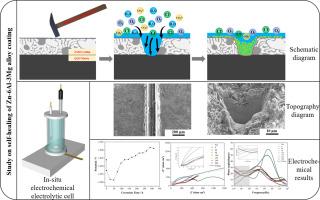Study on the self-healing behavior and corrosion mechanism of hot-dipping Zn-6Al-3Mg alloy coatings in corrosive environments
IF 6.3
2区 材料科学
Q2 CHEMISTRY, PHYSICAL
引用次数: 0
Abstract
The hot-dipping Zn-6Al-3Mg alloy coating exhibits excellent corrosion resistance due to its self-healing ability at the notch position in corrosive environments. Investigating its related corrosion mechanism is of great significance for improving the protective performance of the coating. In this study, multi-scale microscopes were used to characterize the corrosion morphology and product changes during the self-healing process of the coating. Combined with in-situ electrochemical tests, the changes in electrochemical signals during the corrosion process were monitored to analyze the corrosion behavior and self-healing characteristics of the coating. The results show that corrosion products are rapidly formed at the notch position, providing protection for the substrate. With the increase of local pH, a stable and dense multi-layer corrosion product protective layer is formed. The results of in-situ electrochemical tests further confirm that as the corrosion process progresses, the corrosion at the damaged position of the coating is effectively inhibited, that is, self-healing is achieved, and evidence is also provided for the stratification phenomenon of corrosion products.

热浸锌- 6al - 3mg合金涂层在腐蚀环境中的自愈行为及腐蚀机理研究
热浸锌- 6al - 3mg合金涂层由于在腐蚀环境中缺口位置具有自愈能力而表现出优异的耐腐蚀性。研究其腐蚀机理对提高涂层的防护性能具有重要意义。本研究采用多尺度显微镜对涂层自愈过程中的腐蚀形态和产物变化进行了表征。结合现场电化学测试,监测腐蚀过程中电化学信号的变化,分析涂层的腐蚀行为和自愈特性。结果表明,腐蚀产物在缺口处迅速形成,为基体提供了保护。随着局部pH值的增加,形成稳定致密的多层腐蚀产物保护层。现场电化学测试结果进一步证实,随着腐蚀过程的进行,涂层损伤部位的腐蚀得到了有效抑制,即实现了自愈,也为腐蚀产物的分层现象提供了证据。
本文章由计算机程序翻译,如有差异,请以英文原文为准。
求助全文
约1分钟内获得全文
求助全文
来源期刊

Surfaces and Interfaces
Chemistry-General Chemistry
CiteScore
8.50
自引率
6.50%
发文量
753
审稿时长
35 days
期刊介绍:
The aim of the journal is to provide a respectful outlet for ''sound science'' papers in all research areas on surfaces and interfaces. We define sound science papers as papers that describe new and well-executed research, but that do not necessarily provide brand new insights or are merely a description of research results.
Surfaces and Interfaces publishes research papers in all fields of surface science which may not always find the right home on first submission to our Elsevier sister journals (Applied Surface, Surface and Coatings Technology, Thin Solid Films)
 求助内容:
求助内容: 应助结果提醒方式:
应助结果提醒方式:


